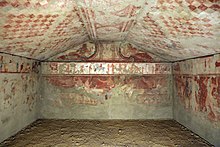Tomba delle Bighe
The Tomba delle Bighe ("Tomb of the two spans ") is an Etruscan tomb in the Monterozzi necropolis of Tarquinia . It was discovered by Otto Magnus von Stackelberg in 1827 and was initially known under the name Tomba Stackelberg . The grave is due to its wall paintings in the years around 490 BC. Dated. After a detail of these paintings, it got its name that is common today. The tomb consisted of an underground chamber, the walls and ceiling of which were painted. The paintings have been in the National Archaeological Museum of Tarquinia since 1949 and have greatly faded since their discovery. They are considered to be extremely original and innovative. Many details of the paintings can only be recognized today on old drawings, especially by Carlo Ruspi (now kept in the German Archaeological Institute in Rome ).
The walls of the tomb have two painted friezes. The main walls show large paintings on a red background. Above it is a narrow frieze on a white background. Sports activities are shown here, such as chariot races, wrestling and fistfighting, long jump, riding, but also discus and javelin throwing. They represent the longest cycle of sporting competitions in Etruscan art. Stylistically, they are often associated with Attic vase painting , while the paintings in the main zone are considered to be authentic Etruscan.
In the gable of the rear wall you can see a painted supporting pillar in the middle. A large crater is shown in it. To the left and right of it are servants. In each of the gable corners lies a man with a drinking bowl for the wine that the servants serve. Athletes are shown in the stripe under the gable. On the short sides of the frieze you can see spectator stands. The spectators sit on benches, underneath which erotic groups are depicted, including homosexual intercourse. The main scene shows a banquet whose participants are lying on Klinen . Such banquet scenes are typical for numerous Etruscan tombs in Tarquinia in the following years. It is first attested here. On the right wall you can see figures dancing and making music. The left wall, which is now heavily damaged, originally also showed dancers and musicians in the main field.
Individual evidence
- ^ Stephan Steingräber : Abundance of Life, Etruscan Wall Painting . Los Angeles 2006, ISBN 978-0-89236-865-5 , p. 103.
- ^ Drawings by Carlo Ruspi in the German Archaeological Institute in the Arachne archaeological database (image database) .
- ↑ Stephan Steingräber (Ed.): Etruscan wall painting. Belser, Stuttgart / Zurich 1985, p. 297.
- ^ Mario Moretti, Leonard von Matt: Etruscan painting in Tarquinia. DuMont Schauberg, Cologne 1974, ISBN 3-7701-0541-9 , p. 92.
- ↑ Stephan Steingräber: Etruscan and Greek Tomb Painting in Italy, C. 700 - 400 Bc , in: JJ Pollitt (Ed.): The Cambridge History of Painting in the Classical World . Cambridge University Press, Cambridge 2015, ISBN 9780521865913 , p. 118.
literature
- Mario Moretti , Leonard von Matt : Etruscan painting in Tarquinia. DuMont Schauberg, Cologne 1974, ISBN 3-7701-0541-9 , pp. 90–92 Fig. 72.
Web links
- Tomba delle Bighe (Italian)
- Boston Museum of Fine Arts, drawing of the left wall (circa 1900) copy of the left wall
Coordinates: 42 ° 14 ′ 22.5 " N , 11 ° 47 ′ 30.8" E

